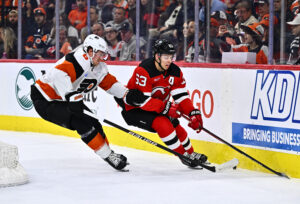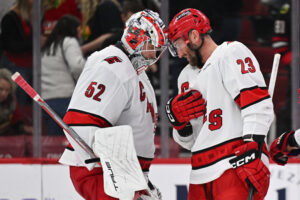Halfway through September isn’t where the Vancouver Canucks fans want to be thinking about contracts. They’ve had more than enough of that in recent years, with stars cutting their current deals quite late. Scoring leader Brock Boeser‘s bridge deal remained unsigned until the end of training camp two years ago. Captain Horvat’s contract was signed just a few days before camp opened. The two Canucks waiting this year — Elias Pettersson and Quinn Hughes — r could mean even more to the team.
How Pettersson and Hughes Deals Will Look
Last time we talked about this, it was quite brief. Our estimate of $12.5 million combined for bridge deals for Elias Pettersson and Quinn Hughes looks awfully optimistic right now, we confess. But in our defence, we’ll plead that the end of May was a different time. You know, before the massive contracts for extensive time frames were signed by defencemen this offseason.
It was also in anticipation of shorter deals coming into play, which is still more likely than both getting long-term second contracts. This didn’t – and doesn’t – look like a bad bet, given the league’s financial circumstance. Even with the optimistic prediction of an increase in the salary cap next season, it will be for a paltry amount. Certainly not enough – one million dollars – to affect negotiations with their star players.
A quick glance at CapFriendly tells us that the Canucks don’t even have room for our predicted deals. So what’s going to happen now? Glad you asked.
The (Latest) Final Countdown
Camp has opened, with rookies and AHLers getting a good look around the place and Canucks coaches and staff getting a look at them. But in another week, the full-time NHL veterans are coming to town, and that puts a different spin on negotiations. Professionals aren’t interested in skipping training camp any more than the team is. And camp this year is all of three days before preseason games begin. So a deal of some kind could arrive before Thursday.
Actually, two of them. For those folks who need a primer, the quick version is this: Pettersson and Hughes are with the same sports agency now. That’s CAA, where Quinn Hughes‘ father works as a development coach. The move by Pettersson means the players are negotiating these deals together. They know exactly how important they are to the team, too. The usual management practice of squeezing a 10.2(c) restricted free agent – that’s Hughes, who can’t receive an offer sheet because of it – isn’t going to work, here. Pettersson is using his leverage to “bodyguard” Hughes’ deal.
You want your players to bond off the ice? Here’s what might happen when you let your players bond off the ice.
Otherwise, the two are in slightly different circumstances. Pettersson is an unrestricted free agent in 2025, while Hughes is in 2026. It doesn’t sound like much, but when the discussion is around bridge deals, those are important dates. Agents want to target unrestricted free agency in any negotiation. Teams, obviously, would rather not. With Pettersson and Hughes – along with Thatcher Demko – forming the core of the Canucks’ future, why isn’t Jim Benning handing them the world?
Making Marks
The easy excuse is the salary cap. Look at that, hands are tied, etc. But after the rather astounding overhaul where contracts were shredded for higher risk, it becomes much harder to justify. The team has kept money available to deflect any offer sheet to Pettersson, of course. But that’s not to say they’re pretending the money doesn’t exist, either. As of now, the Canucks have 24 players on their roster and one player – Micheal Ferland – on injured reserve. They officially have about $10.67 million in cap space, and a couple of waiver-exempt players they can “paper down” in Jack Rathbone and Nils Höglander if they wish.
After doing all that, the maximum active roster is only 23 players. That means someone’s got to move, either through trade or demotion. There are a lot of options there, and every other team in the league will be doing the same, so the risk of losing players is minimal. It looks like the Canucks are going to be operating in long-term injury relief mode again this season. This takes advantage of Ferland’s career-ending concussion, but stops the team from gaining cap space by “moving” players back and forth to the AHL.
All told, the Canucks actually have somewhere around $16.5 million available, assuming Ferland’s deal doesn’t get moved. It will be even tighter next year when bonuses will come due and Boeser’s deal is up – and he has arbitration rights. That extra $1 million cap space is looking even smaller now, isn’t it? So again, what’s the big deal? Why aren’t Pettersson and Hughes signed already?
Checks and Balances
As harsh as it sounds, there can still be some question of what exactly the Canucks have in their two star skaters. While Hughes is likely to have his jersey retired by the team if he remains a Canuck for long, there are weaknesses to his game. Cale Makar and Miro Heiskanen are defencemen at his skill level and his age group, but they both have stronger possession numbers and play better defence. Having said that, this isn’t a slight on Hughes. This could change in the next couple of seasons and no one would be shocked. But if he wants a long-term, big number deal then a bridge while he matures is probably his best bet.
The team will be pitching for the maximum term, but that’s their gamble to make. If Hughes does improve, even if it’s keeping his boxcar numbers while solidifying play in his own end, that price won’t come down for the next deal.
As for Pettersson, his skill speaks for itself. Placing a bet on his hitting a point-per-game in 2021-22 won’t get you great odds, as he’s almost certain to be one of the better players in the NHL this season. He is a phenomenally smart player and works extremely well with Boeser – happy coincidence – and J. T. Miller. His shot is extremely good, and his passing exemplary. He is going to be a regular in the league’s top-20 in scoring for several years to come. But will it be with the Canucks, or somewhere else?
Winning When it Matters
For both Pettersson and Hughes, age is a factor. Neither player has finished developing into their peak performance. If Pettersson moves beyond top-20 into top-5 range, then he’s going to be worth a lot of money. But he’s not there yet, and there’s a chance he won’t be. Stars win games, but depth wins championships. While the difference between an 80-point player and a 110-point player is huge in a hockey pool, in the league, that doesn’t actually change a whole lot. Except for around three million dollars a season.
It’s simple economics that the star players make teams money. Not just ticket sales, but jersey sales and posters and TV deals and all the rest. Those stars should be paid accordingly. But in a salary cap world, it’s a zero-sum game for players. Trying to fit in scoring depth while promoting young talent and paying your stars is a hard act to pull off. Teams who think they’re close have tried pitching for stars as free agents, and that doesn’t often work out. That 110-point player is usually only a 110-point player for a few seasons at best. After that, the cap hit stays while the scoring diminishes.
The Tampa Bay Lightning lost their entire – very good and very expensive – third line this off-season, sure. Having said that, this only occurred after they won their second consecutive Stanley Cup. How they managed their money is a big part of those wins. Everyone in the league knows it, players, general managers, and owners alike. And for Pettersson and Hughes and the Vancouver Canucks, negotiation is key.
Main Photo: Embed from Getty Images






